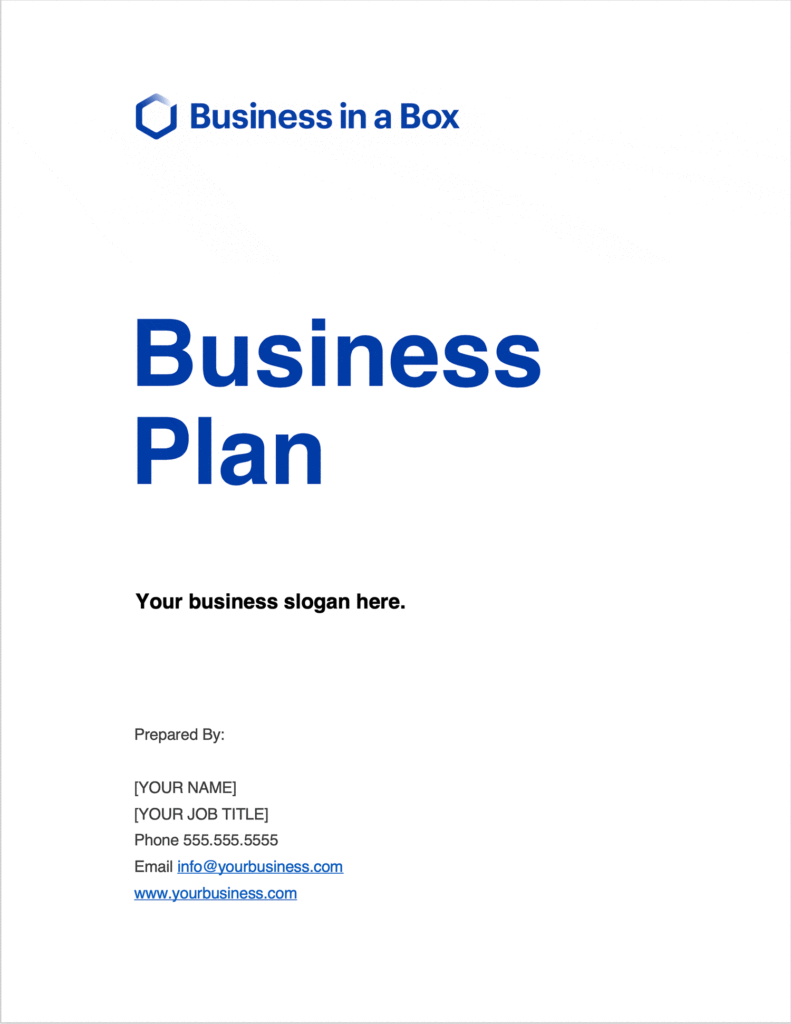One very important foundation of any successful business is a solid, top-level business plan. Business plans help businesses define their vision, get appropriate funding, operate effectively in their business space, and evolve to meet their unique goals.
A business without a plan will find it difficult to navigate through the difficulties of the business world. However, it’s not enough to only have a hypothetical business plan. For business plans to be effective, they must be put into writing and used as a guide for the business to achieve its goals.
A solid, well-written business plan is beneficial in a lot of ways. First, it’s the ultimate guide that the business follows to get desirable results. Then, it’s also useful as a tool that helps to analyze and showcase prospective operational and growth plans to prospective investors when need be. According to Forbes.com, business plans help accelerate the chances of growth and success of a business.
Writing a worthy business plan, however, doesn’t come easy for all business owners. It’s a lot more than downloading a random business plan template and using it. There are specific plans for different types of businesses, and the key is ensuring that you find one that’s specific and just right for your type of business.
Here, we’ve put together a detailed guide that will show you the important steps to take in writing a unique top-level business plan for your business.

Download Now: Free Business Plan Guide
Tips for an Effective Business Plan
First, we take you through the important things to have in mind before writing a business plan.
● Why do I need this business plan?
There are a number of reasons why you may need a business plan. Some of them include:
- Idea validation: In situations where you conceive a business idea and still haven’t figured out if it’s a viable business model or not, a business plan can help you get the details on paper and fine-tune the idea.
- Investment purposes: When seeking funding from venture capitalists or angel investors, a solid business plan is one of the key foundational documents to have.
- Loan applications: Banks also require formal business plans when seeking loan applications.
- Internal purposes: Aside from external affairs, business plans are also very useful for a business that requires an internal roadmap for management and growth.
According to Entrepreneur.com, no one format fits all when writing a business plan. Why you need a business plan will influence the style you employ in writing your business plan.
● Who is the audience?
The recipient of your business plan will determine the language, tone, and length of your business plan. For instance, having a business in a niche space doesn’t necessarily mean that your business plan will be in a niche language, especially if you’re targeting a reach of bank officials or investors who don’t necessarily have vast knowledge about the niche space. Therefore, it’s important to know the audience you’re writing your business plan for.
Similarly, whether you’ll have a one-page business plan or a 50-page business plan will depend on the audience. For internal purposes, you may need a more detailed plan that you can continually refer to as the business grows. However, for external and funding purposes, most potential investors may require a short business plan.
Always put your audience into consideration when preparing to write a business plan.
Business Plan Template [Download Now]
Essential Sections to Include in Your Business Plan
A business with a good and comprehensive business plan may accomplish more in a shorter amount of time. Here are some essential sections to include in your business plan.
1. Executive Summary
In the first part after the title page, the executive summary is a summarized outline of the business and the plans. Typically it’s either a page or two, and it’s expected to tell the reader what you want.
A good executive summary should be able to stand alone without the rest of the document, as it’s believed to contain the highlights of the business plan. It’s not uncommon for venture capitalists or investors to request the executive summary alone during the evaluation stage. For that reason, the executive summary should contain important information like;
- The problem your business is looking to solve,
- A description of the service or product,
- A brief description of key employees,
- Business and financial background,
- A synopsis of your target audience, amongst others.
Summarily, the question your executive summary should answer is, “why should the reader believe in my business?”
2. Business Description
This is where you can go into more details about your business. It contains a brief description of your industry and how the business fits into it. It should also contain the present realities of the industry and the future prospects. More information on the different markets within your industry, and the effects they can have on your business should also go into this section.
The question the business description should endeavor to answer is “what makes my business different from others and what are we capitalizing on?”
3. Competitive Analysis
This section is about the relationship between you and other competitors within the industry. First, a brief description of your target audience will show who your business is targeted at, and how existing businesses are already serving them.
However, you’ll go on to explore their advantages and disadvantages, and how your business will capitalize on those disadvantages. All necessary information about the current state of your target market and industry will be included in this section.
The question you should answer in this section include:
- In what areas are my competitors doing well?
- Where are they lacking?
- How can I take advantage of that?
4. Marketing and Sales Strategies
This aspect of your business plan is a result of a thorough market and competitive analysis. Following your competitive analysis, this section is expected to include details on how you’ll market and sell your products or services to your target market. Therefore, you should have details like pricing plan, logistics plans and cost, prospective partnership deals, and possible business hurdles in this section.
This section also compels the business owner to be realistic about the different aspects of the strategies and position the business for greater outputs and opportunities.
The question this section poses is “what is the best possible way to go about the business for the best output?”
5. Management and Operational Structure
An important aspect of a business is ensuring that you have the right team and structure on the ground to carry out and manage those great business plans. This section is used to illustrate the current and prospective team members, their experiences and qualifications, and history.
It’ll also be used to describe the legal and business structure that works best for the type of business. Some of the most common structures used for businesses are;
- Limited Liability Company,
- C-corp,
- S-corp,
- Partnership, and
- Sole Proprietorship.
This gives investors insight into how the business will be run as an organization, an overview of its operational structure, and the management plans already in place or those in the works. The question for this section include:
- How will my business operate daily?
- What legal structure fits our plan best?”
Another important thing you can do is to create an organizational chart, just in case you have multiple stakeholders.
6. Products and Services
This section is commonly referred to as the major part of business plans. While every section is important, this is where you give the most details about your product or service. Here, you’ll find information about the product, the problem it intends to solve, what solution it’s bringing to the table, and how it fits into the existing business landscape.
First, paint a descriptive picture of your product or service, its relevance to your target audience, and its difference from related products.
Then, reiterate your competitive advantages, and intellectual property rights that relate to your product. You can close the section by analyzing your product milestones or metrics. This will point out the next steps in line and ensure the reader understands the exact state the product is in at that very moment.
Ensure that you describe your products in detail, especially with regards to how it’s different from similar products. Answering the “what’s your good or service that’s for sale?” questions will take up a lot more space and pages when compared to other sections.
7. Raise Capital
This segment is included when your target audience is investors or lenders. Including this segment ensures that your funding request is clear – be clear on how much you’re asking for and why you need it. One aspect that investors look out for in this segment is the projected ROI for the business. The question in mind for this section should be “how much am I asking for and what exactly will it be used for?”
8. Financial Projections
This is typically the final segment of a good business plan template. This section tells the story of your financial plan. It’s characteristically the most difficult for business owners because it requires a lot of details and forecasting. An average financial projection will include the following;
- Sales and revenue projections: This begins as a monthly revenue forecast for the first 12 months and then moves on to annual projections for the next 3 to 5 years. Afterward, it can become a 3-year projection.
- Profit and loss statement: This is the income statement that indicates whether you’re making profits or not.
- Cash flow statement – this keeps track of the amount of cash that you have at different points.
- Balance sheet – this indicates the general health of the business because it shows a complete list of all assets, liabilities, and equity that exist in the business.
As reinstated by Entrepreneur magazine, what backs up a business plan is financial data, and it’s for that reason that this segment is important. It also doesn’t matter if your business plan is about requesting funds or not. Every viable business plan includes a financial projection section.
For businesses that have operated for some years before the business plan is drawn, your goal should be to establish financial stability. However, newer businesses should work towards more realistic projections.
One key to doing this right is making adequate research into industry norms and other competitive businesses. Include income statements, balance sheets, and cash flow statements for multiple years if possible. The question for this important section is “how has my business performed financially in the past, and how will it continue into the future?”
9. Appendix
This isn’t a compulsory aspect of the business plan, but if there’s any piece of information that doesn’t fit into any of the previous segments, this is the place to include it.
A typical startup business plan appendix contains charts, definitions, tables, legal notes, or any other important information.
Additional Business Plan Writing Tips
A good business plan leads to increased efficiency and productivity. Here are additional tips for writing a top-level business plan.
● Be concise with your business plan.
Having a long business plan doesn’t guarantee a successful business, nor does it get extra funding attention. The key is to keep it short and simple. As long as you include the necessary information and segments, your business plan will be viable.
● Use free business plan templates.
There are well over 161 business plan examples available on the internet today. If you’re having a hard time starting out writing a top-level business plan, you can check out some solid business plan templates.
● Get feedback.
It’s important to get feedback from those willing to give, or free resources on the internet. Start sharing the plan as soon as you start, so it’s easy to get feedback before the plan is supposedly done.
Final Thoughts
When starting a business, a business plan is one of the very first things to take care of. Not only does it help you define your business goals and serve as a business management tool, it also positions your business for better opportunities before prospective business partners or investors.
However, it’s not enough to know that you need a business plan or know the content to include. The important step is creating your unique business plan. Several business plan templates exist to help you define your different business plans and goals. Business-in-a-Box has over 2,000 free and paid business plan templates and tools that have helped numerous business owners start, run, and grow their businesses, some of which may be useful to you also.
Sign up to Business-in-a-Box today to get access to thousands of templates and get a copy of the free how-to to write a business plan guidebook.
Good luck!















